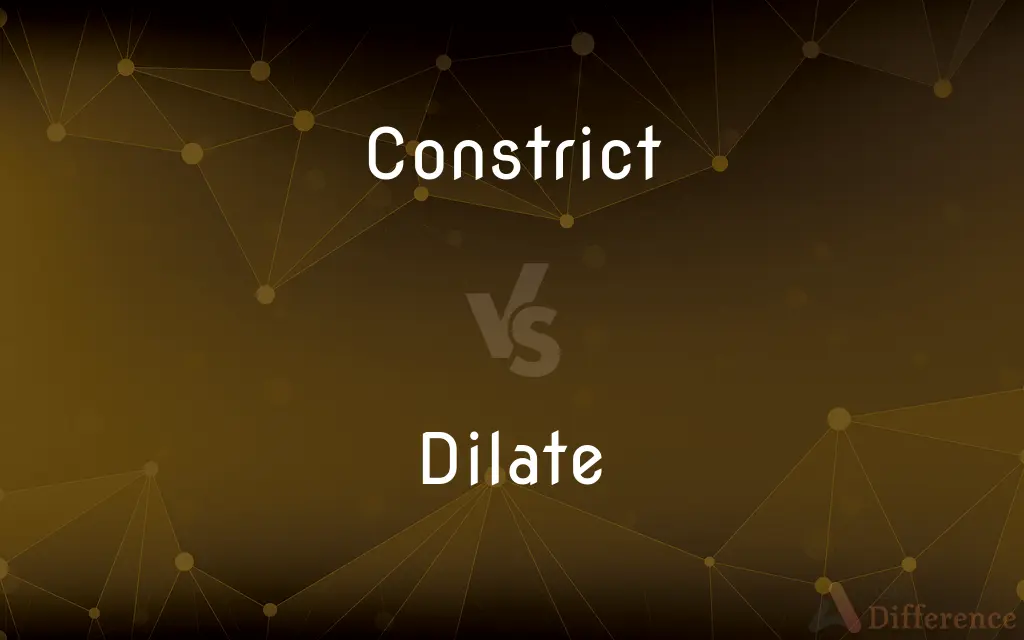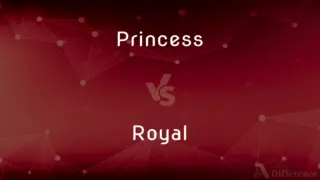Constrict vs. Dilate — What's the Difference?
By Fiza Rafique & Maham Liaqat — Updated on April 8, 2024
Constrict means to narrow or tighten, reducing space or opening, while dilate means to widen or expand, increasing space or opening.

Difference Between Constrict and Dilate
Table of Contents
ADVERTISEMENT
Key Differences
Constriction refers to the process of becoming narrower or the action of making something narrow, often used in medical or biological contexts, such as blood vessels constricting in response to cold. On the other hand, dilation involves the widening or enlarging of spaces or openings, such as the dilation of pupils in low light to allow more light to enter the eye.
When blood vessels constrict, blood flow is reduced, and blood pressure can increase, a mechanism often triggered by stress or cold temperatures. Conversely, dilation of blood vessels increases blood flow and can decrease blood pressure, beneficial in conditions requiring improved circulation.
In terms of muscle movement, constriction is associated with the tightening or closing of a passage or opening, such as the constriction of the esophagus during swallowing. Dilation, however, is related to the opening or relaxing of muscles, like the dilation of the airways to increase airflow to the lungs.
The physiological responses of constriction and dilation serve various purposes, including temperature regulation, the body's response to stress, and the adjustment of blood flow to different parts of the body. Dilation can also occur in response to medication, such as dilating the bronchi in asthma treatment, contrasting with constriction’s role in reducing swelling through the constriction of blood vessels.
Comparison Chart
Definition
To make narrower or tighter
To make wider or larger
ADVERTISEMENT
Biological Example
Blood vessels constricting
Pupils dilating
Effect on Blood Flow
Decreases blood flow
Increases blood flow
Physiological Role
Increases blood pressure, reduces swelling
Decreases blood pressure, improves circulation
Use in Medicine
Used to reduce blood flow or swelling
Used to improve circulation or airflow
Compare with Definitions
Constrict
Can increase pressure within a system.
Constricted arteries can lead to higher blood pressure.
Dilate
To expand or make wider.
The doctor used drops to dilate the patient's pupils for the examination.
Constrict
Often a protective or reflex action.
The pupils constrict in bright light to protect the eyes.
Dilate
Involves the enlargement of openings or passages.
Breathing deeply dilates the airways, improving oxygen intake.
Constrict
To tighten or make narrow.
Cold temperatures cause the skin's blood vessels to constrict, reducing blood flow.
Dilate
Can decrease pressure within a system.
Dilated blood vessels help to lower blood pressure.
Constrict
Used in medical treatments to reduce swelling.
Certain medications constrict blood vessels to alleviate nasal congestion.
Dilate
A response to environmental conditions.
In darkness, pupils dilate to absorb more light.
Constrict
Involves the reduction of an opening or passage.
The snake constricted its prey, tightening its coils.
Dilate
Used in medical treatments to improve flow.
Asthma inhalers dilate the bronchi, making breathing easier.
Constrict
To make smaller or narrower by binding or squeezing.
Dilate
Make or become wider, larger, or more open
Her eyes dilated with horror
The woman dilated her nostrils
Constrict
To squeeze or compress.
Dilate
Speak or write at length on (a subject)
The faithful could hear the minister dilate on the role religion could play
Constrict
To restrict the scope or freedom of; cramp
Lives constricted by poverty.
Dilate
To make wider or larger; cause to expand.
Constrict
To become constricted.
Dilate
To become wider or larger; expand.
Constrict
(ambitransitive) To narrow, especially by application of pressure.
Dilate
To speak or write at great length on a subject; expatiate.
Constrict
To coil around (prey) in order to asphyxiate it.
Dilate
(transitive) To enlarge; to make bigger.
The eye doctor put drops in my eye to dilate the pupil so he could see the nerve better.
Constrict
(figurative) To limit or restrict.
Dilate
(intransitive) To become wider or larger; to expand.
His heart dilates and glories in his strength.
Constrict
To draw together; to render narrower or smaller; to bind; to cramp; to contract or cause to shrink.
Such things as constrict the fibers.
Membranous organs inclosing a cavity which their contraction serves to constrict.
Dilate
(ambitransitive) To speak largely and copiously; to dwell in narration; to enlarge; with "on" or "upon".
Constrict
Squeeze or press together;
She compressed her lips
The spasm contracted the muscle
Dilate
To use a dilator to widen (something, such as a vagina).
Constrict
Become tight or as if tight;
Her throat constricted
Dilate
To expand; to distend; to enlarge or extend in all directions; to swell; - opposed to contract; as, the air dilates the lungs; air is dilated by increase of heat.
Dilate
To enlarge upon; to relate at large; to tell copiously or diffusely.
Do me the favor to dilate at fullWhat hath befallen of them and thee till now.
Dilate
To grow wide; to expand; to swell or extend in all directions.
His heart dilates and glories in his strength.
Dilate
To speak largely and copiously; to dwell in narration; to enlarge; - with on or upon.
But still on their ancient joys dilate.
Dilate
Extensive; expanded.
Dilate
Become wider;
His pupils were dilated
Dilate
Add details, as to an account or idea; clarify the meaning of and discourse in a learned way, usually in writing;
She elaborated on the main ideas in her dissertation
Common Curiosities
What does it mean to constrict?
Constricting refers to the action of making something narrower or tighter, often reducing the flow or movement through it.
How do constrict and dilate affect blood pressure?
Constriction typically increases blood pressure by narrowing blood vessels, while dilation lowers blood pressure by widening them.
What does dilate mean?
Dilating means to widen or expand an opening or space, allowing for increased flow or movement.
Can both constriction and dilation be beneficial?
Yes, both processes serve important physiological roles, such as regulating blood flow, adjusting to environmental conditions, and facilitating bodily functions.
How do constrict and dilate relate to body temperature regulation?
Constriction can reduce blood flow to conserve heat, while dilation increases blood flow to release heat, aiding in temperature regulation.
What role does pupil dilation play in vision?
Pupil dilation allows more light to enter the eye, improving vision in low-light conditions.
How are constriction and dilation used in medicine?
Medications can induce constriction or dilation to treat various conditions, such as reducing swelling or improving blood flow and oxygen intake.
How do constricting and dilating agents work in the body?
These agents chemically signal the smooth muscles to tighten or relax, affecting the diameter of blood vessels or airways.
What causes blood vessels to constrict or dilate?
Factors include temperature, stress, chemical signals, and medications, affecting the body's regulatory mechanisms.
Are constriction and dilation voluntary processes?
They are primarily involuntary, controlled by the autonomic nervous system, though some practices, like breathing techniques, can influence them.
Is dilation always a sign of a positive response?
Not necessarily; while it can indicate a positive response like improved blood flow, it can also be a reaction to stress or injury.
Can constriction and dilation occur simultaneously in different parts of the body?
Yes, the body can constrict vessels in one area while dilating them in another to prioritize blood flow to essential organs.
How does exercise affect constriction and dilation?
Exercise can cause dilation of blood vessels in muscles for increased blood flow, while vessels in other areas may constrict to maintain blood pressure.
Can emotional states affect constriction and dilation?
Yes, emotional states like stress can cause blood vessels to constrict, while relaxation can lead to dilation.
What are some examples of medical conditions that involve constriction or dilation?
Conditions include hypertension (associated with constriction) and asthma (treated with dilation of airways).
Share Your Discovery

Previous Comparison
Princess vs. Royal
Next Comparison
Celebrant vs. CelebratorAuthor Spotlight
Written by
Fiza RafiqueFiza Rafique is a skilled content writer at AskDifference.com, where she meticulously refines and enhances written pieces. Drawing from her vast editorial expertise, Fiza ensures clarity, accuracy, and precision in every article. Passionate about language, she continually seeks to elevate the quality of content for readers worldwide.
Co-written by
Maham Liaqat













































